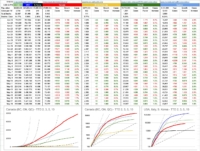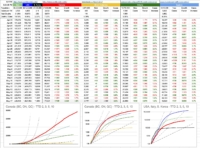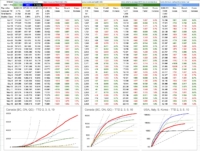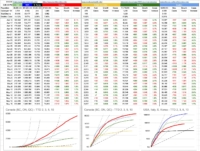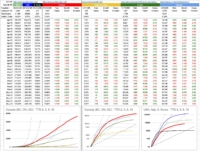Share...
Day 63 – May 18, 2020
Forty years ago, to the day… May 18, 1980, I was lying in bed reading… a lazy Sunday morning… reading, and listening to LG73. I had a window open, so the loud boom shortly after 8:32am was very audible. It rattled the windows. What the hell was that, I thought to myself? Nothing like a car crash, and everything else was silent outside. A distant bomb? Those teenagers across the back lane that always seemed to have a stash of firecrackers? I finally decided it must have been a big tree that fell over. Not that I’d ever heard a tree fall over near me… but then again, I’d also never heard a volcano 300 miles away blast 1.4 billion cubic yards of ash 80,000 feet into the sky.
But that’s what happened that morning, when Mount. St. Helens blew her stack. What’s interesting about it is that nobody was expecting it, and it came as a complete surprise. How could we ever have prepared for it?
Yeah, that’s complete nonsense. Experts from many disciplines had been well-aware of the strange rumblings around Mt. St. Helens for months… there had been a small earthquake on March 20th, the first of thousands over the next eight weeks. There had been 16,000-foot ash plumes. There had been fresh craters. There had been sightings of magma. While things got quiet again in late April and early May, there was an increasing bulge on the north face that was growing by 5 feet per day. On May 7th, things started firing up again, and the bulge’s growth became worryingly inconsistent. Geologist David Johnston, camped 5.5 miles away, dutifully kept measuring and reporting his findings. The last of those reports was at 6:53am. His last words, captured shortly after 8:32am by a nearby ham-radio operator were, “Vancouver! Vancouver! This is it!” — a message to his fellow USGS researchers, at the University of Washington in Vancouver, WA., that never made it. Two miles away, Gerry Martin, a radio operator tasked with observing the volcano for the state’s department of emergency services, saw what had happened and what was coming. His last words were, “It’s going to get me, too”.
There were only 57 deaths attributable to that eruption, and I say “only” because that number could have been … [Continue Reading]
Day 62 – May 17, 2020
Queueing Theory is a fascinating branch of math that deals with the science behind… queues, as in line-ups. First of all, let’s take a moment to admire that word… queueing… how often do you see a word with five vowels in a row?
When it comes to line-ups, there’s more to it than you might think. The variables used in analyzing queues involve things like how often do new people show up to join the queue? How often is the person at the front getting pulled out of it? How long does it take to process and then get rid of that person? How long is too long? …because arriving people may see a long line and just say forget it.
The red velvet rope that delineates where to stand plays an important psychological role. If you arrive, and the queue extends past the end of the rope, you might think the line is too long, and bail….but if there’s lots of room and the rope extends way back… well — it can’t be too bad, right? Straight line vs snaking line? Should you be able to see the whole line, or should some of it be hidden?
Nightclubs play a balancing act… perhaps you’ve been to clubs where you wait outside a while, finally go in, and the place is half-empty. They make you stand in line to appear busy… to attract others to come…but, of course, if the line is too long, you may be dissuaded to wait… it’s a fine… line.
Some of it is fancy math, and some of it is just social engineering, but fundamentally, there are right and wrong ways to do queues. Like, what’s better… 6 independent line-ups for individual bank tellers, or one central line-up that sends the person at the front to the next open window? That one is a no-brainer… pretty-much everywhere that can support the latter has switched to that model. It’s not necessarily better for an individual who might luckily pick the fastest line, but it’s the fairest… and from a psychological point of view, that keeps everyone happy because it’s balanced. It’s very aggravating to be standing in a slow-moving line while everyone else is moving around you. And if you picked that line, part of you is thinking you “lost”.
Day 61 – May 16, 2020
In 1966, a researcher (Gordon Stephenson) conducted an interesting experiment. He put 5 monkeys in a locked room. There wasn’t much in the room except a sort of ladder in the middle of it. At some point, he lowered a bunch of bananas within reach of the top of the ladder, and eventually, one of the monkeys noticed them and scampered up the ladder to grab them… as soon as the monkey touched the bananas, he (and all of the monkeys) were sprayed with cold water. This caused quite a frenzy, as you might imagine. Eventually, after they’d calmed down, another one of the monkeys decided to try his luck, ran up the ladder… and was met with the same fate. Cold shower for all of them. The disgruntled monkeys eventually learned that maybe it wasn’t worth it.
Then, one of the monkeys was removed, and a new one was placed in the room. And that monkey, as soon as he saw the bananas, made a move towards climbing towards them, but was quickly subdued by the other monkeys. He must have been confused, so he tried again, but again, was jumped by the others.
Then, another one of the monkeys was removed and a new one put in his place. As expected, the same thing happened. And, quite interestingly, the monkey that’d never even been sprayed joined in the ruckus, helping keep the new monkey away from the bananas.
And then this happened a few more times; a new monkey would be cycled in, and get beat up for trying to reach the bananas… by all of the others. Eventually, all of the monkeys that’d ever been sprayed had been replaced, but the behaviour continued. If you’re less than civilized, and just want to fit in… indeed, by virtue of needing to survive, you have to fit in… you just go with the crowd, even if you don’t understand the behaviour.
If monkeys could talk, and you’d ask them what’s going on… why aren’t you letting anyone reach those bananas… their answer might be, “That’s just the way it is”.
Apart from being a great song by Bruce Hornsby — a song that instantly comes into my head when I hear those words — those words, throughout history, have been used to “excuse” some … [Continue Reading]
Day 60 – May 15, 2020
“Collect as much data as you can for now.” — this is a mantra that is common in many different disciplines, especially the ones where you’re not sure what data matters. One day, you’ll have a chance to look back on it and figure out what matters, but for the most part, especially initially, the thing to do gather as much as you can, and eventually learn from it.
“Eventually” could mean decades from now. It could also mean tomorrow. In fact, it could even mean 15 minutes from now. On that note, as you’re reading this, somewhere, on the periphery of your focus, there are ads and sponsored posts and other slight differences that are being thrown at you; an experience that will differ slightly for someone else. Some of it is based on your history, but some of it is just data collecting… like, does it work better to use this ad or that ad? Does it work better in red or green? Does it work better positioned here or there? This data is all being crunched, often in real-time — to deliver to you the most pleasant experience possible. Haha, sorry, not quite — to deliver to you the most profitable experience for someone… is the better answer. Facebook is worth $500 billion, and their revenue stream has to come from somewhere, since 99.999% of the people who use Facebook have never given them a penny… so, rest assured, those who are paying want to make sure they’re getting their maximum bang for the buck.
And, of course, an awful lot of data is being collected about this virus, and there are disagreements about what’s important. As per above, it’s always a good idea to gather it all and then figure out later what matters and what doesn’t. Sophisticated modelling techniques do this all the time. For example, a neural network. That sounds a lot fancier or scarier than it really is. It’s not some sort of artificial brain which can think for itself, become sentient and launch an attack on humanity… rather, it’s just software for taking a ton of data, much of it possibly unrelated, and grinding through it in such a way that it “learns” what inputs are relevant to outcomes, and which are noise. A … [Continue Reading]
Day 59 – May 14, 2020
Thinking about my time in Northern Chile, in Copiapó, a few decades ago… led me to realize how much of that experience has aspects relatable to a lot of what’s going on these days… around here and around the world. Here’s an interesting sociological observation…
Back then, there wasn’t much to do except work. With no TV and only one radio station, it felt very much cut-off from the rest of the world. There was exactly one magazine kiosk that got anything in English, and everything was always, at best, a couple of days behind. But a 2-day-old New York Times was better than nothing, and I’d read every word of it. Most days looked like this: You’d be up early, get to work… work until lunch… which could turn into a 3-hour break if you threw errands and a siesta in there… and then back to work, till about 7pm. Then an hour or two of socializing, and then dinner… then sleep, and back to it next day.
It was about an 8-hour work day… 8:30am to 1pm, 3:30pm to 7pm… and the socializing to which I refer was often not more than wandering the streets and running into people and chatting. A feature of every single city, town, village in Latin America is what’s called the “Plaza de Armas” — a central plaza, usually located near the heart. Any place that has at least two sets of parallel roads will have the middle of that tic-tac-toe, and that is the de-facto Plaza de Armas. Often, it’s much bigger… 2 or 3 sets of streets ending at the square from all sides. A 3×3 block of grass, trees, paths, benches, statues. And the hub of outdoor social activity.
I lived a block away from the Plaza, so I was there often… and it was great. Lots of people milling around, kids kicking soccer balls around. It was also a commercial area… some artisans selling their work, and the permiter around the plaza on all sides — that was the “downtown”, if that’s the right word… populated with government offices, businesses of all sorts; the typical eclectic collection of one-off mom-and-pop shops, including two thirds of the entire town’s restaurants.
But right around that time is when things began to change.
Some Latin-American satellite TV … [Continue Reading]


